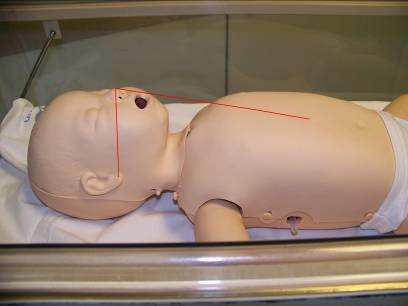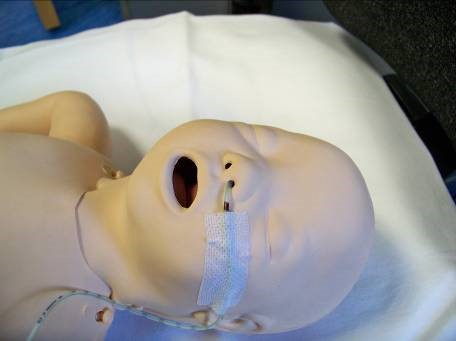Passage of a nasogastric or orogastric feeding tube (neonatal guideline)
exp date isn't null, but text field is
Objectives
This guideline is applicable to all medical, nursing and midwifery staff working in neonatal units in the West of Scotland. All staff should complete a competency based training programme to ensure passage of a nasogastric or orogastric feeding tube will be standardised throughout the neonatal service. Staff should also familiarise themselves with the Wospghan document entitled “Enteral tube feeding Information pack for healthcare professionals”
- 1 sterile hand towel
- 1 disposable tape measure
- Appropriate sized gastric tube ( see further information section)
- Appropriate means to mark tube position i.e. indelible ink marker pen or tape
- A hydrocolloid dressing is recommended for preterm infants or infants with broken skin as a base dressing. The tube can then be secured to the hydrocolloid with tape.
- 1 x 10ml oral syringe
- 1 pH indicator strip
- Oxygen and suction available
NB - If a chest or abdominal x-ray is being performed in a baby who is likely to need a feeding tube it is best practice to ensure that the tube is passed prior to the x-ray being performed. The x-ray will confirm the position of a tube even if you are unable to obtain an aspirate.
- Carry out hand hygiene before handling the baby, non-sterile gloves can be worn if preferred.
- Assemble equipment and place in an accessible position for carrying out the procedure.
- Ensure the infant is in a comfortable position and swaddled if required.
- The baby’s face should be gently cleaned with water, dried and then a small strip of hydrocolloid tape applied to the face either level with the nostrils or at the sides of the mouth. The tube is then secured to the hydrocolloid dressing using tape.
- With the head in the neutral position, determine the length of tube to be inserted by measuring from the earlobe to the tip of the nose (nasogastric) or from the earlobe to the centre of the lips (orogastric), then to the midpoint between the xiphisternum and the umbilicus. Note the measurement and mark the tube accordingly (see photographs below). Place marker pen line or tape approx 1cm away from nose or mouth.

Measurement to be taken for passage of a nasogastric tube
Nasogastric tube fixed in position with an indelible pen marker 1cm from nose. NB smaller babies, or those with damaged skin, should have a hydrocolloid dressing applied under the tape - If the nasogastric tube is being passed for the first time, either nostril can be used. If the tube is being replaced, try to pass it down the opposite nostril to that used previously. Orogastric tubes are obviously passed by the oral route and are indicated for smaller babies with consequently small nasal passages on nasal CPAP or in any other conditions involving blockage or obstruction of the nares.
- A nasogastric tube should be gently passed into the nostril then advanced carefully in an upward, backward and slightly medial direction. If there is any obstruction, pull the nasogastric tube back and re-advance. If the obstruction continues, try the other nostril. Non-nutritive sucking and/or sucrose, may reduce distress to the infant during the procedure and may also stimulate peristalsis. Any evidence of obstructed nasal passage should be documented and medical staff informed. An orogastric tube is passed in a more backward and downward fashion. The use of lubricating jelly such as Aquagel may assist in the passage of a nasogastric tube if the procedure is proving difficult.
- The feeding tube should be advanced until 1 cm before the measured length of the black marker has been reached. Secure the tube in position to the side of the face using fixation as described above, prior to attempting to aspirate gastric contents.
- If at any time the infant starts coughing or becomes cyanosed, stop the procedure and remove the tube.
- Check inside the baby’s mouth to ensure that the tube is not coiled up at the back of the throat.
- Attach the syringe to the gastric tube and aspirate just enough to test gastric Ph (no more than 0.2ml).
- Cover the pH strip with the aspirate and allow 10 -60 seconds for the colour to develop.
- A pH reading of 5.5 or below should indicate satisfactory placement of the tube but remember to always match the pH strip with the colour code chart on the booklet or box - if in any doubt, do not feed. If you are unable to obtain any aspirate or pH is above 5.5, refer to WoS guideline “Nasogastric / Orogastric Tubes: Confirming Position” for troubleshooting information.
- Ensure that documentation is completed – note on SCBU / ITU chart date that a new tube was passed, size of tube used, the measured length of the tube and the pH level of the gastric aspirate.
- If the baby is having bolus feeds, aspirate the tube and test for pH level prior to every feed using minimum of aspirate (no more than 0.2 ml). If the baby is on continuous feeds or is receiving nil orally, aspirate the tube and test the pH level every 4-6 hours. In addition, should there have been any vomiting, retching or coughing or should there be any indication that the tube may have become dislodged (loose tapes, pen mark line further than 1 cm from nose / mouth) the tube should be aspirated and pH again estimated.
- Surgical neonates: refer to surgeon’s instructions regarding aspiration of gastric contents. Until feeds are fully established gastric contents are discarded.
- Infants < 2kg will usually have a 5 fg gastric tube. Where infants of <2kg have a nasogastric tube AND concurrent NCPAP or Nasal High Flow therapy, a 4fg tube should be used to minimise obstruction of the nares.
- Infants > 2kg will usually have a size 6 fg gastric tube passed
- In bigger babies, where thickened feeds are prescribed, larger diameter tubes (size 8 fg) may be required to administer feeds.
- Surgical Infants will initially require size 8fg gastric tube passed, once nasogastric aspirates decrease an appropriate sized tube can be passed.
- A size 10 fg gastric tube is passed orally when gut decompression is required – congenital diaphragmatic hernia, gastroschisis or large amounts of bilious aspirates due to bowel obstruction.
- Oesophageal Atresia – A size 10 fg Replogle tube is passed orally and continuous suction of 5 Kpa is applied. The oesophageal pouch should be flushed with 0.5 ml 0.9% Sodium Chloride every 15-30 minutes and the tube observed closely for patency afterwards.
- Gastric tubes stoppers are closed when they are not used for the administration of bolus feeding. Free drainage of gastric tubes is used when gut decompression is required. To carry out free drainage, the external end of the tube is inserted into a bile bag and the stopper opened.
- If an infant, who is receiving NCPAP therapy, has gaseous abdominal distension (‘CPAP belly’), they may have the gastric tube attached to a syringe barrel which is then elevated. This may allow excess air to be vented from the stomach.
- Short-term gastric tubes are made of polyvinyl chloride and can remain in place for up to a week. Items marked ‘single use’ or
 should not be re-used.
should not be re-used. - Gastric tubes are usually passed nasally for ease of insertion and fixation thus minimising the risk of displacement, but as this occludes one nostril, gastric tubes may be passed orally when there is evidence of respiratory distress. An orogastric tube should be inserted when choanal atresia, cleft palate or Maxillo-facial conditions are diagnosed. Both orogastric and nasogastric tubes are currently used in clinical practice in neonatal units. Rationale for choice is determined by individualised infant care and unit policy.
Anderton, A (1999) Microbial Contamination of Enteral Tube Feeds – How can we reduce the risk? Nutricia Clinical Care.
Beckstrand, J., Ellett, M. L.C., & McDaniel, A. (2007). Predicting the internal distance to the stomach for positioning nasogastric and orogastric feeding tubes in children. Journal of Advanced Nursing, 59 (3), 274-289.
Ellett M.L.C., et al (2011). Predicting the length for gastric tube placement in neonates. Journal of Obstetric, Gynecologic and Neonatal Nursing, 40 (4), 412-421.
Ellett M.L.C., et al (2012) Comparing the methods of determining insertion length for placing gastric tubes in children 1 month to 17 years of age. Journal of Specialists in Pediatric Nursing.17, 19-32.
Husband, S and Trigg, E (2002) Practices in children’s nursing : guidelines for hospital and community. Edinburgh: Churchill Livingston.
NHS QIS (2003) Nasogastric and Gastrostomy Tube Feeding for children being cared for in the community. Best Practice Statement. Edinburgh NHS QIS.
NPSA Patient Safety Alert -“Reducing the harm caused by misplaced naso and orogastric feeding tubes - neonates” September 2005
Spence, K (2003) Nutritional management of the infant in the NICU in Boxwell, G ed Neonatal Intensive Care Nursing 3rd ed. Routledge: London. Ch.11.
Last reviewed: 14 October 2019
Next review: 01 October 2022
Author(s): Andrena Kelly – Nurse Educator - Neonatal Surgical Department, RHC
Approved By: West of Scotland Neonatal Managed Clinical Network

